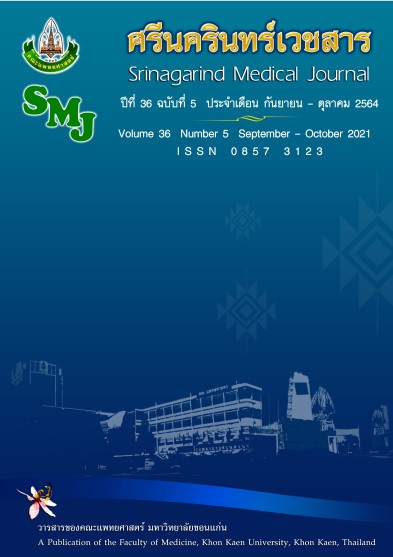การเปรียบเทียบระหว่างการผ่าตัดม้ามโดยการส่องกล้องโดยใช้ LigaSure และการผ่าตัดม้ามแบบเปิดหน้าท้องในโรคที่ไม่ได้เกิดจากอุบัติเหตุ
Abstract
Comparison between Laparoscopic Splenectomy Using LigaSure and Open Splenectomy for Non-traumatic Diseases
Araya Khaimook1*, Phadungkiat Tipmanee1, Sujaree Bhimonpun1, Arunchai Chang2,
1 Division of Minimally Invasive Surgery, Department of Surgery, Hatyai Hospital, Songkhla, Thailand
2 Division of Gastroenterology, Department of Internal Medicine, Hatyai Hospital, Songkhla, Thailand
Short running head: Lap VS. Open Splenectomy for Non-traumatic disease
Type of manuscript: Original paper
*Corresponding author: Araya Khaimook, Division of Minimally Invasive Surgery, Department of Surgery, Hatyai Hospital, Songkhla, 90110 Thailand. E-mail: araya@cpird.in.th
Telephone: +66815424454 Fax: +6674273100
บทคัดย่อ
หลักการและวัตถุประสงค์: การผ่าตัดม้ามโดยการส่องกล้องได้กลายเป็นแนวทางมาตรฐานสำหรับความผิดปกติของม้ามที่ไม่ได้เกิดจากอุบัติเหตุ การศึกษาในอดีตพบว่าการผ่าตัดม้ามโดยการส่องกล้องด้วยเครื่องมือ LigaSure ในการห้ามเลือดบริเวณขั้วม้ามมีประสิทธิภาพและความปลอดภัย การศึกษานี้เปรียบเทียบประสิทธิภาพและความปลอดภัยของการผ่าตัดม้ามโดยการส่องกล้องโดยใช้เครื่องมือ LigaSure กับการผ่าตัดม้ามแบบเปิดหน้าท้องผู้ป่วยที่เป็นโรคที่ไม่ได้เกิดจากอุบัติเหตุ
วิธีการศึกษา: เราทำการศึกษาย้อนหลังเปรียบเทียบข้อมูลการผ่าตัด ภาวะแทรกระหว่างการผ่าตัด และ ผลลัพธ์การรักษาต่างๆระหว่างการผ่าตัดม้ามโดยการส่องกล้องกับการผ่าตัดม้ามแบบเปิดหน้าท้อง
ผลการศึกษา: ผู้ป่วยเข้ารับการผ่าตัดม้ามทั้งหมด 25 ราย ผ่าตัดม้ามแบบเปิดหน้าท้อง 6 ราย ผ่าตัดม้ามโดยการส่องกล้อง 19 ราย โดยผู้ป่วยเข้ารับการผ่าตัดม้ามแบบเปิดหน้าท้องใช้เวลาในการผ่าตัดสั้นกว่าผู้ป่วยเข้ารับการผ่าตัดม้ามโดยการส่องกล้อง (45 นาทีเทียบกับ 100 นาที p= 0.030) ผู้ป่วยเข้ารับการผ่าตัดม้ามโดยการส่องกล้องมีคะแนนความเจ็บปวดหลังการผ่าตัดน้อยกว่า (7 คะแนนเทียบกับ 3 คะแนน p< 0.001) และสามารถเริ่มรับประทานอาหารได้เร็วกว่า (18 ชั่วโมงเทียบกับ 6 ชั่วโมง p= 0.003) ทั้งนี้ไม่พบผู้เสียชีวิตทั้งสองกลุ่มและไม่พบความแตกต่างอย่างมีนัยสำคัญทางสถิติแง่ภาวะแทรกระหว่างการผ่าตัดระหว่างผู้ป่วยทั้งสองกลุ่ม (ร้อยละ 16.7 เทียบกับร้อยละ 26.3% p= 0.629)
สรุป: การผ่าตัดม้ามด้วยการส่องกล้องโดยใช้ LigaSure นั้นปลอดภัยและมีประสิทธิภาพสำหรับผู้ป่วยที่เป็นโรคที่ไม่ได้เกิดจากอุบัติเหตุ ทั้งนี้การผ่าตัดม้ามด้วยการส่องกล้องมีความสัมพันธ์กับระยะเวลาการผ่าตัดที่ยาวนานขึ้น ความเจ็บปวดหลังการผ่าตัดน้อยลง และเริ่มรับประทานอาหารทางปากได้เร็วขึ้นเมื่อเทียบกับการผ่าตัดม้ามแบบเปิดหน้าท้อง โดยไม่มีความเสี่ยงที่เพิ่มขึ้นของการตกเลือดระหว่างการผ่าตัดและภาวะแทรกซ้อนระหว่างการผ่าตัด
คำสำคัญ: การผ่าตัดตัดม้ามผ่านกล้อง; การตัดม้ามแบบเปิด; ตัดม้าม
Background and Objective: Laparoscopic splenectomy (LS) has become the standard approach for non-traumatic splenic disorders. Previous studies demonstrated the effectiveness and safety of LigaSure for the dissection and sealing of splenic pedicels in LS. This study compared the efficacy and safety of LS using LigaSure and open splenectomy (OS) in patients with non-traumatic disease.
Materials and Methods: We retrospectively reviewed patients who underwent LS and OS. Operative data, perioperative course, and clinical outcome were assessed.
Results: In all, 25 patients were included in the analysis; 6 in the OS group, and 19 in the LS group. The OS group had a significantly shorter duration of surgery (median [interquartile range; IQR] = 45 [30-95] vs. 100 [60-120] minutes, p=0.030). The LS group had significantly lower post-operative pain scores (median [IQR] = 7 [6-9] vs. 3 [1-5], p<0.001) and shorter time to step diet (median [IQR] = 18 [18 to 24] vs. 6 [6 to 18] h, p=0.003). No mortality occurred in either group. There was no significant difference in perioperative complications between the two groups (16.7% vs. 26.3%, p=0.629).
Conclusion: Laparoscopic splenectomy using LigaSure appeared safe, feasible, and efficacious for non-traumatic splenic disorders. LS using LigaSure was associated with a significantly longer duration of surgery, lesser postoperative pain, and faster resumption of oral diet compared to OS, without increased risks of intraoperative bleeding and perioperative complications.
Keywords: Laparoscopic splenectomy; open splenectomy; splenectomy; LigaSure


